Battle for Zendikards, Part One
The preview weeks are over, so it's time for me to start telling some card-by-card and cycle-by-cycle design stories. I have a lot to say, so let's jump right in.
Adverse Conditions
This is alphabetically the first devoid card, so it seemed like a good place as any to talk a little bit about devoid design. As I explained during preview weeks, I wanted to have a single unifying quality for the Eldrazi, and colorlessness seemed to fit best. I always wanted to keep from messing too badly with the color pie, so devoid was the solution to making all the Eldrazi colorless while still ensuring that color mattered. The issue I did not discuss was this: What threshold did we need to cross to make a card feel suitably Eldrazi?
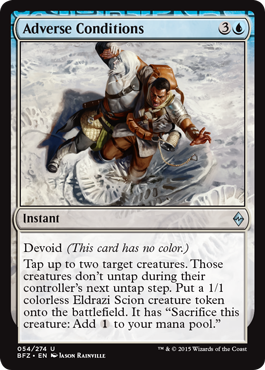
In other words, we couldn't just take any card in the set, add devoid, and be done with it. A card with devoid had to feel like an Eldrazi. How did we decide what was good enough? We had some basic rules we used.
#1—If it was a creature, it had to be creature type "Eldrazi."
The choices are simple. You can be just an Eldrazi, you can be an Eldrazi Drone, you can be an Eldrazi Processor, or you can be an Eldrazi Scion. Processors have to use up cards in the exile zone and Scions are the creature tokens (the 1/1 creatures that can sacrifice themselves for one colorless mana). The key here is, if you are an Eldrazi, you say so on your card type line.
#2—It can exile something.
To communicate the hunger of the Eldrazi, we have them exiling many different things. One easy way to have your devoid spell feel "Eldrazi" is to simply have it exile something. You'll see that we got pretty clever with how to work the exiling in. For creatures, having the ingest keyword often accomplished this task.
#3—It can produce Scions.
An Eldrazi spell can do almost anything if a side effect of casting it is you get a Scion creature token.
#4—It can help colorless things in some way.
The Eldrazi are all colorless, so an easy way to feel "Eldrazi" is to help out colorless permanents and/or spells. As we'll see, different color combinations help out different things.
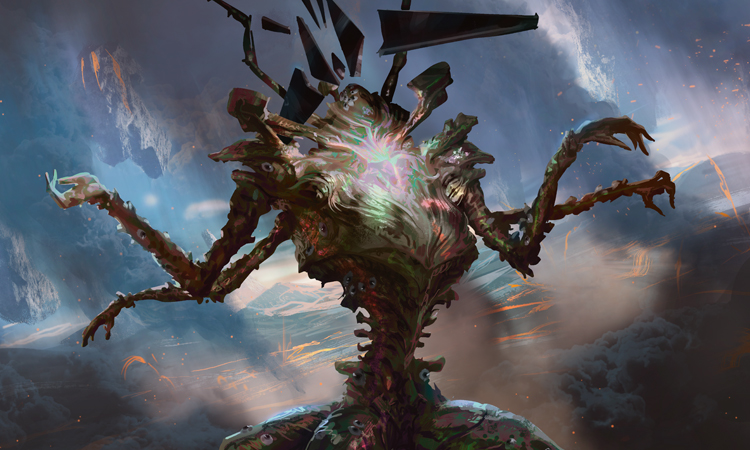
Herald of Kozilek | Art by Johannes Voss
#5—You can make use of cards your opponent owns in exile.
One of the Eldrazi things is consuming exiled cards owned by the opponent. A few spells do this, although it is most often done by creatures with the creature type Processor.
#6—It can feel invasive.
This last category is mostly for creatures. There are a few Eldrazi that don't follow any of the previous rules, but have an overall sense of being threatening. This was mostly done when we were trying to make a simple, non-wordy Eldrazi creature.
And those were the rules governing what you needed to do to be devoid.
Akoum Stonewalker
We knew coming back to Zendikar that we wanted to bring back landfall, as it was the most popular mechanic from the original block. One of goals, though, was to explore some new things we could do with it. The solution came from an interesting series of events.
In Worldwake, we made a landfall card called Seer's Sundial. It was an artifact that allowed you to draw a card whenever a land entered the battlefield. We made it expensive, because we knew drawing a card was a pretty substantial effect. It wasn't getting played, so we tweaked it by making you have to pay two when it triggered to get the card. This allowed us to make the card cheaper and easier to get onto the battlefield.
When we were working on Battle for Zendikar, we thought back to Seer's Sundial and realized that there was some design space to explore. Having to pay mana with landfall triggers meant that it could do bigger, splashier things. We experimented with it and found that our initial inclination was right, it opened up new design space. So we made a vertical cycle of landfall with additional mana costs.
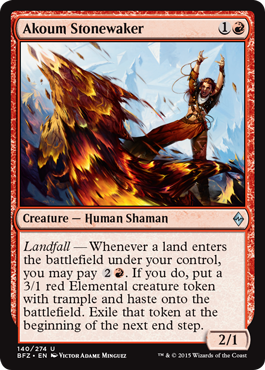
Allied Hedron Network
This card was 100% a top-down design. We were back on Zendikar, so we felt we needed to have a card represent some hedrons, as the hedrons are one of the most iconic components of Zendikar. The big question we asked ourselves was what exactly do hedrons do? We knew of only one thing—the hedrons were used by Ugin, Sorin, and Nahiri to trap the Eldrazi. Okay, was there a way we could do that?
We experimented with a few different versions, but all of them involved the hedrons neutralizing a big creature. We ended up with the current version, because an Oblivion Ring-style effect did the best job of feeling like it was imprisoning the creature. Break it open—much like Thalia broke open the Helvault—and the creature returns to the battlefield.
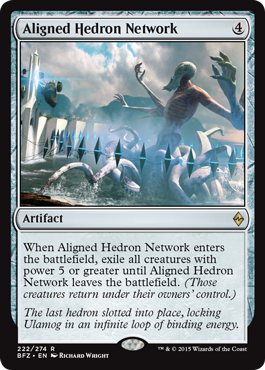
Bane of Bala Ged
This card caused all sorts of trouble during design and development. As I explained during the preview weeks, annihilator didn't work out so well last time we saw the Eldrazi. It was not all that popular, it led to poor game play, and it was nearly impossible to cost any creature with the ability cheaply. While designing Eldrazi, we ended up making this one. At the time, many people questioned why this card didn't have annihilator.
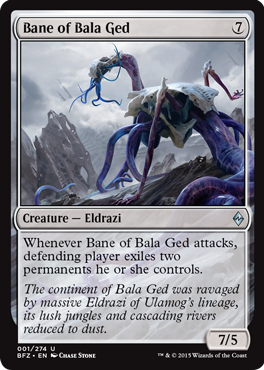
The technical answer is that the card forces the player to exile the permanents rather than sacrifice them, but we sensed that there was a concern. This led to the question: Since we're not doing annihilator, should we avoid cards that seem to occupy similar space? We debated this point in design and decided to keep it. The issue also came up in development—they then had a very similar discussion and also decided to keep it.
I bring this up because now that you all know the card, I'm fielding the same question from the public. If annihilator was so bad, why make a card with almost-annihilator? The answer is that there is a big difference between a single card doing something and an entire mechanic doing something. We felt that one card in that space was acceptable, and it was a little bone to throw the annihilator fans.
Blighted Cycle
This cycle came about because we were trying to think of different ways to make use of land. The original Zendikar block had cycles of land that came into play tapped and had enters-the-battlefield triggers. We would repeat that again, but we also were interested in trying a different way to get a "spell" effect out of a land.
Well, if we did enters-the-battlefield last time, how about doing something when the land is put into the graveyard? That required land sacrificing effects, which historically have not been all that fun. What if the land had an activation that required sacrificing it to generate an effect? We could then cycle it out, giving each color an activation, which would then allow us to do colored-spell effects.
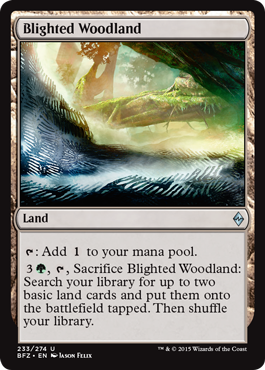
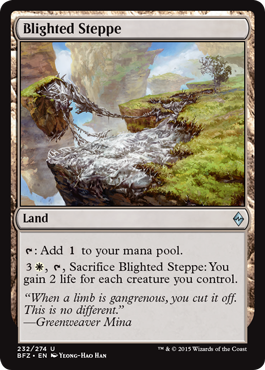
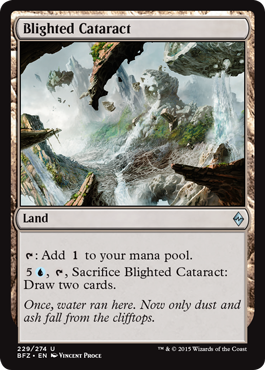
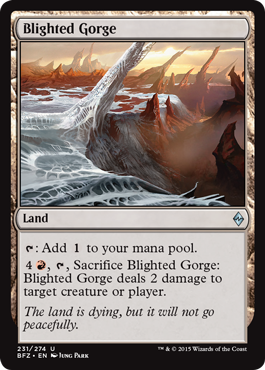
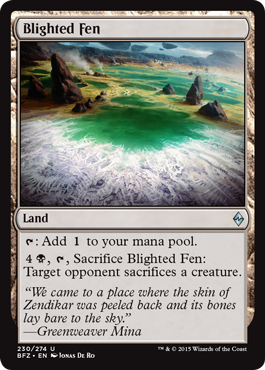
The reason the lands ended up producing a colorless mana is the cards were already wordy, and having them produce colored mana would require them to come into play tapped or have some additional cost like life payment. Either of those would have added an additional line on the card, which would have impacted the type of effects we could do, so we left them producing colorless mana. The creative team then took the ball and ran with it, making these lands represent areas devastated by the Eldrazi.
Call the Scions
One of the most common questions I've gotten about Battle for Zendikar has been about the Scions and what colors produce them. In Rise of the Eldrazi, we tied black, red, and green to Eldrazi, so the Spawn-making was in those three colors. Battle for Zendikar is a different set with different needs, so we shook things up a little.
In a vacuum, we felt like green and blue made the most sense. Green has always made a lot of token creatures and is king of mana production. Blue also has some token-making (all five colors do), and it's best at producing colorless mana. Green ended up being the color that most often made multiple Scions. Blue Scions were mostly generated by enters-the-battlefield effects on creatures. As we fleshed out what the colors did, we decided we wanted a third color for a few cards, and it ended up fitting best in black.
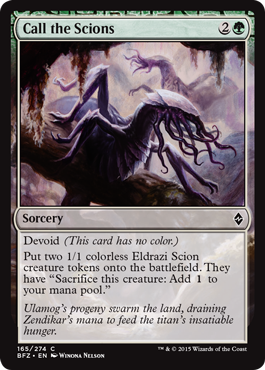
Cryptic Cruiser
As I explained in one of the preview columns, design's versions of the Processors cared which or how many cards your opponent had in exile. Development tried this version, but found the scalable effects to be too hard to balance. Erik Lauer, the set's lead developer, came up with the idea that instead of looking at the cards in exile, the Processors could somehow use them up.
Erik and his development team made a bunch of cards and had a playtest. Erik invited me to the playtest, because he was interested in my take on the new version of the mechanic. The thing that sold me on it was Cryptic Cruiser. You see, all the other Processors I had were one-shot enters-the-battlefield effects, and I was finding that I could always meet their exile cost. But then I drew Cryptic Cruiser, and with its repeatable effect, I found I wanted to use the ability every turn. But my opponent didn't have enough cards in exile, so I was forced to think through how and when to use my opponent's exile cards as a resource. I found that interaction very fun.
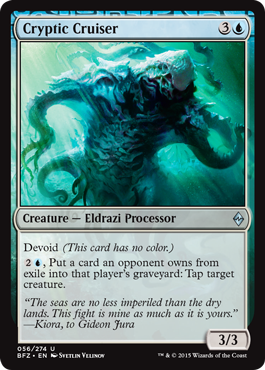
After the playtest, I talked with Erik and gave him my blessing on the new version of Processors. My one request was that they make more cards like Cryptic Cruiser.
Deathless Behemoth
We made plenty of cards that created Scions (or more accurately Spawns, in design), but one of design's goals was to also make cards that could allow players to use Scions in different ways. The big question was about how best to do that. One idea we came up with was cards that sacrificed Scions as a cost. That way you could use Scions to get the Eldrazi out, and then if you made more Scions after it was out, you could use them to generate an effect.
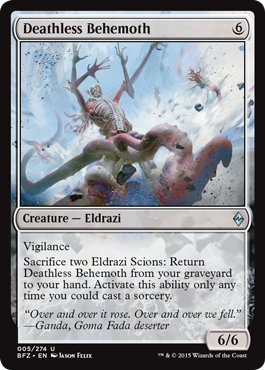
Deathless Behemoth came about because we were trying to figure out what we could do with Scions. We experimented with sacrificing Scions to grant the creature defensive abilities like hexproof or regeneration. But we didn't want the activations to require mana, just sacrificing Scions, so they ended up being a little too strong. That led us to the idea that you could use the Scions to regrow the creature. It did a lot of what the defensive abilities did, but allowed us to sneakily add mana in because you have to recast it.
Dragonmaster Outcast
I've spent a lot of time talking about how the new two-block paradigm is structured, but I've spent less time talking about the impact of removing the core sets. We're making the same number of cards each year, but one big thing has gone way down: reprints. For most of its life, the core set was all reprints. But even after the revamping in Magic 2010, usually about half the cards were new.
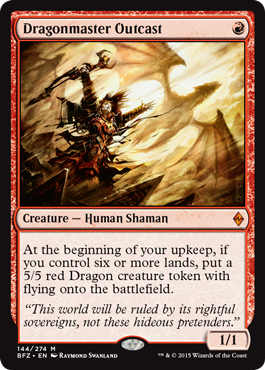
We talked about the impact of this change and we realized that if we want reprints in the game, we're going to have to be a little more liberal with using reprints in normal expansions. Dragonmaster Outcast is a good example. When the core sets were around, we repeated very few rares or mythic rares. Under the new system, we're being more conscious about bringing things back. Dragonmaster Outcast, as an example, was very popular with casual players when Zendikar was out, and we felt like it would be a fun card to reprint in Battle for Zendikar.
Dust Stalker
Once we knew that we were going to make colorlessness matter, the next question was which colors we wanted to put those abilities into. We were keeping the Eldrazi out of white, so white was no longer a choice. Green was mostly focusing on making Scions, and its normal interaction with colorless things was to destroy them. That left us with blue, black, and red.
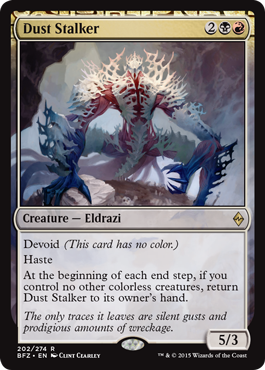
Playtesting showed us that there were actually two different areas that we could care about: permanents and spells. The first cared about getting colorless permanents onto the battlefield, while the second cared more about playing colorless spells. When we looked at the archetypes that needed a theme, black-red and blue-red stood out. Blue-red is normally more spell-based, as blue and red are the two colors with the lowest percentage of creatures. That meant blue-red wanted to care more about colorless spells.
Black-red tended to be more aggressive about using creatures, so having colorless permanents made sense. Playtesting showed us that the colorless permanent theme worked better if the threshold needed wasn't too high, so we tended to make black and red get a bonus if a single other colorless permanent was in play.
Encircling Fissure
Awaken proved to be a tricky mechanic. As a rider, you got to permanently animate a land. The problem is when we add a rider, we like for the rider to mechanically connect with the rest of the spell. Well, what exactly works with animating a land? More than you might think, it turns out.
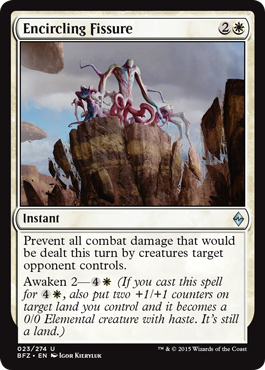
Encircling Fissure is a fine example of a good awaken design. The card is a Fog variant: It prevents damage dealt by the creatures of target opponent. Why does this work well with animating a land? Because the Fog is one-sided, meaning if you block with a creature, you have the ability to stop (and possibly destroy) an attacker without any threat of losing your creature. Awaken makes sure you have a creature to block with.
Also, for most of the awaken cards, we made them sorceries because we didn't want them to be surprise ambush cards. We made one exception, and that was in white. To offset this, we made the white awaken effects smaller.
Endless One
I'm not sure why, but designing creatures with a mana cost of X is just fun to do. The first one we ever made was in Visions on a card called Phyrexian Marauder.
It was clunky and pretty weak, but I remember being happy we had done it. Then in Stronghold, a year later, we made another one. This time a Wall. I had wanted to just straight-up make a creature for X that was an X/X, but at the time it was considered too good.
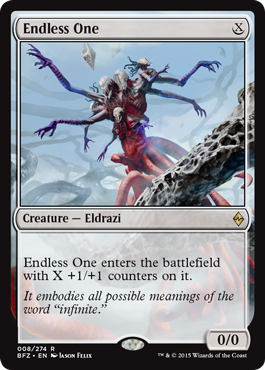
It took many years, but I finally got my X for an X/X. The key apparently was to wait until creatures got better, when X for an X/X just became more reasonable.
From A to E
Well, I've run out of time for today, but I've only made it to E. That means I'll be back for at least one more installment. As always though, I'm interested in hearing feedback from you, about this column or Battle for Zendikar in general. You can contact me through my email or through any of my social media accounts (Twitter, Tumblr, Google+, and Instagram).
Join me next week for more card-by-card design stories.
Until then, may you have as much fun playing Battle for Zendikar as we did making it.
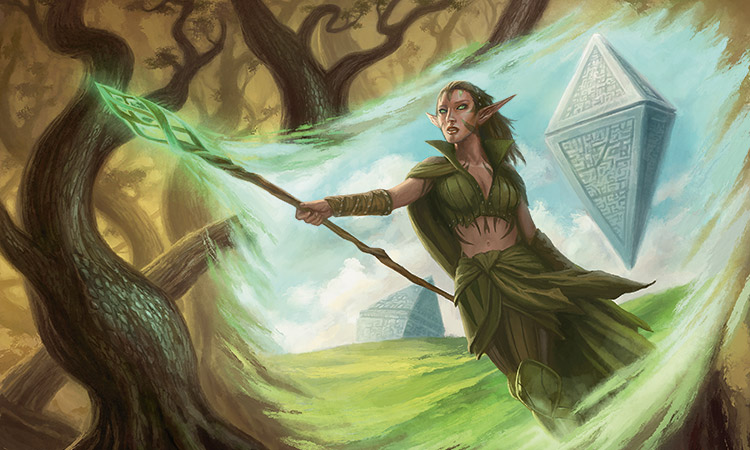
Nissa's Expedition | Art by Dan Scott
"Drive to Work #262—Khans of Tarkir, Part 7"
This is part seven of a seven-part series on the design of Khans of Tarkir.
"Drive to Work #263—2012"
This is another podcast in my series "20 Years in 20 Podcasts," where I go year-by-year explaining everything that happened during each year of Magic's existence. I'm up to 2012.
- Episode 263 2012 (14.4 MB)
- Episode 262 Khans of Tarkir, Part 7 (17.5 MB)
- Episode 261 Khans of Tarkir, Part 6 (17.3 MB)
- Episode 260 10 Things Every Game Needs – Fun (21.1 MB)
- Episode 259 Khans of Tarkir, Part 5 (18.0 MB)

